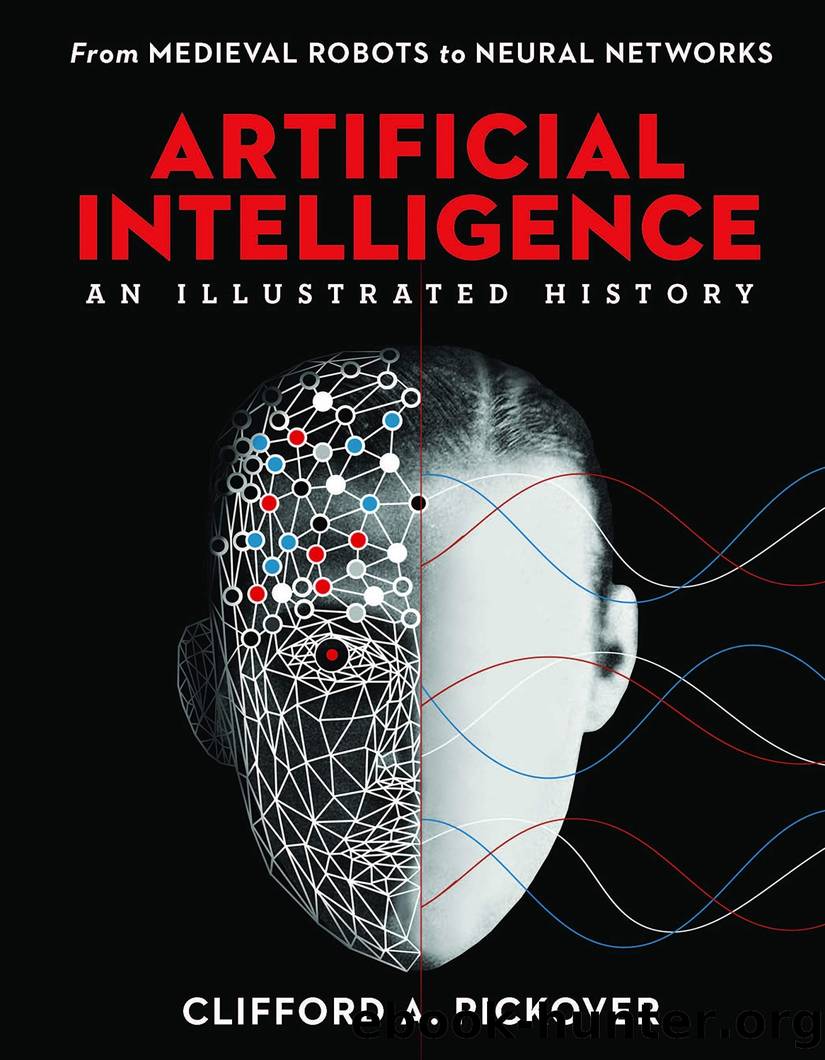Artificial Intelligence: An Illustrated History: From Medieval Robots to Neural Networks by Clifford A. Pickover

Author:Clifford A. Pickover [Pickover, Clifford A.]
Language: eng
Format: epub
Tags: Computers, Intelligence (AI) & Semantics, Science, General, Technology & Engineering, Robotics
ISBN: 9781454933595
Google: 3yNawwEACAAJ
Amazon: 1454933593
Publisher: Sterling
Published: 2019-10-01T23:00:00+00:00
SEE ALSO Aristotleâs Organon (c. 350 BCE), Tower of Hanoi (1883), Perceptron (1957), Machine Learning (1959), Expert Systems (1965), Fuzzy Logic (1965)
Joseph Licklider wrote: âThe hope is that . . . human brains and computing machines will be coupled together very tightly, and that the resulting partnership will think as no human brain has ever thought.â
1960
LICKLIDERâS âMAN-COMPUTER SYMBIOSISâ
In 1960, psychologist and computer scientist Joseph Licklider (1915â1990) published a seminal paper titled âMan-Computer Symbiosis.â He begins his essay by explaining a symbiotic relationship of a fig tree, which is pollinated by a Blastophaga wasp whose eggs and larvae derive nourishment from the tree. In the same way, Licklider proposed, humans and computers could form a symbiotic relationship. In the early years of symbiosis, humans would set the goals and formulate the hypotheses as computers prepared the way for insights. Some problems, he wrote, âsimply cannot be formulated without computing-machine aid.â
Rather than envisioning computer-based entities replacing humans, Licklider was more aligned with Norbert Wiener (1894â1964), whose theories of cybernetics tended to focus on close interactions between humans and machines. In the paper, he explains: âThe hope is that . . . human brains and computing machines will be coupled together very tightly, and that the resulting partnership will think as no human brain has ever thought and process data in a way not approached by the information-handling machines we know today.â
Licklider also discusses âthinking centersâ that he believed would incorporate the functions of traditional libraries, and he suggested the need for natural-language processing for symbiosis.
In his essay, Licklider concedes that âelectronic or chemical âmachinesâ will outdo the human brain in most of the functions we now consider exclusively within its province,â and he provides examples of chess playing, problem solving, pattern recognizing, and theorem proving. He clarifies that âthe computer will serve as a statistical-inference, decision-theory, or game-theory machine to make elementary evaluations of suggested courses of action. . . . Finally, it will do as much diagnosis, pattern-matching, and relevance-recognizing as it profitably can. . . .â
Nearly sixty years later, Lickliderâs paper still raises important questions about the potential union of human intelligence and AI: When the day comes that we have a coupling with machines even more than we have today, will a symbiotic person still be considered a âhumanâ? Will such a person ever consider disengaging from the computer?
Download
This site does not store any files on its server. We only index and link to content provided by other sites. Please contact the content providers to delete copyright contents if any and email us, we'll remove relevant links or contents immediately.
| AI & Machine Learning | Bioinformatics |
| Computer Simulation | Cybernetics |
| Human-Computer Interaction | Information Theory |
| Robotics | Systems Analysis & Design |
Algorithms of the Intelligent Web by Haralambos Marmanis;Dmitry Babenko(8516)
Test-Driven Development with Java by Alan Mellor(7311)
Data Augmentation with Python by Duc Haba(7218)
Principles of Data Fabric by Sonia Mezzetta(6965)
Learn Blender Simulations the Right Way by Stephen Pearson(6892)
Microservices with Spring Boot 3 and Spring Cloud by Magnus Larsson(6732)
RPA Solution Architect's Handbook by Sachin Sahgal(6131)
Hadoop in Practice by Alex Holmes(6025)
Jquery UI in Action : Master the concepts Of Jquery UI: A Step By Step Approach by ANMOL GOYAL(5865)
The Infinite Retina by Robert Scoble Irena Cronin(5831)
Big Data Analysis with Python by Ivan Marin(5675)
Life 3.0: Being Human in the Age of Artificial Intelligence by Tegmark Max(5393)
Pretrain Vision and Large Language Models in Python by Emily Webber(4636)
Infrastructure as Code for Beginners by Russ McKendrick(4417)
WordPress Plugin Development Cookbook by Yannick Lefebvre(4149)
Functional Programming in JavaScript by Mantyla Dan(4115)
The Age of Surveillance Capitalism by Shoshana Zuboff(4107)
Embracing Microservices Design by Ovais Mehboob Ahmed Khan Nabil Siddiqui and Timothy Oleson(3940)
Applied Machine Learning for Healthcare and Life Sciences Using AWS by Ujjwal Ratan(3911)
